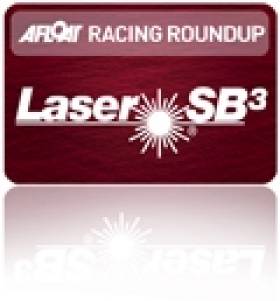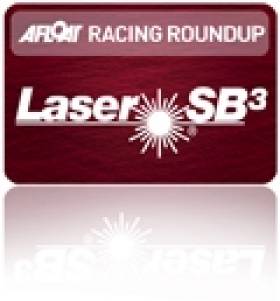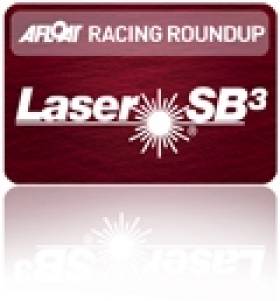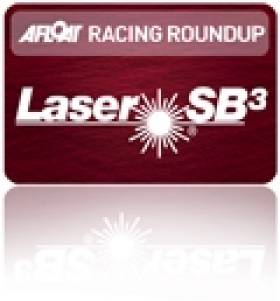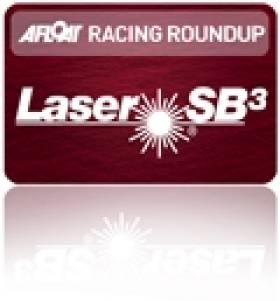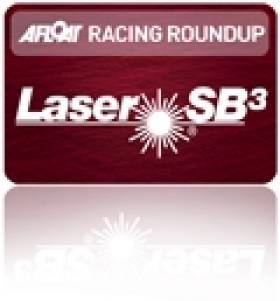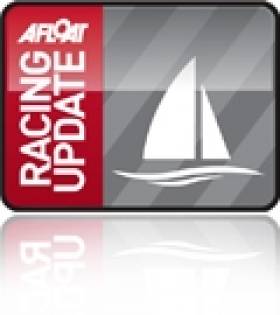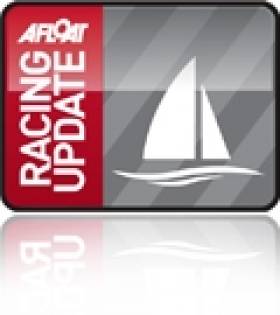Displaying items by tag: Laser SB3
Clyde SB3 Class Continues to Grow
Following beer and pizza a 40 minute presentation was given which was followed by an open question and answer session. The presentation covered a range of points including; an overview of the boats, opportunities for the 2012 season, berthing & launching facilities, available boats and sponsorship opportunities. Feedback from those that attended would suggest that the evening was a success and we are now aware of a further 2 definite owners presently looking for boats as well as 4 other individuals or syndicates giving the opportunity serious consideration.
At the request of some of the attendees we will be holding a demo sail weekend on Saturday 26th November between 11:00 – 14:00 (weather dependent) where interested owners and crew can come and try out a boat. If you are interested and have not already registered for a demo sail, can you please email Douglas Paton ([email protected]) with your preferred time.
Sharkbait earns home win in SB3 Easterns
The Howth crew of Ben Duncan, Brian Moran and Rick Morris on ‘Sharkbait’ are this year’s SB3 Eastern Champions after the six-race series ended on home waters with the local boat tying on points with Cork visitor ‘Sibelius’ (Kieran Dorgan) but taking the title on countback, having two bullets to the rival’s one. Overall results table here.
Brian Carlin SB3 photos from the event on the Afloat Gallery
Consistency was the name of the game, with ‘Sharkbait’ never out of the top four and ‘Sibelius’ notching three third places, a second and a 5th. Both crews are heading to Torbay in mid-May for the SB3 Worlds so this was a useful work-out, especially in difficult conditions. The north-easterly winds were fresher but steadier than on the first day but the swell was significantly greater, making life tougher on crews and equipment.
That only five points after discards separated the top five boats overall speaks volumes for the intensity of the competition at the head of the 30-boat fleet. These five dominated proceedings to such an extent that the difference in points after discards between fifth and sixth overall was a massive 26 points.
After leading overnight by a slender margin, ‘Sharkbait’ got off to a dream start to the second day with a bullet ahead of’Flutter’ (Andrew Algeo) and Dorgan in the fourth race of the series. Fourth-placed Peter Kennedy of RNIYC in ‘Ridgefence.com’ was making amends for his OCS on the Saturday by following up that result with a win in the penultimate race, with ‘Flutter’ again second. Sean Craig’s ‘Yeti’ was third while Duncan and Dorgan filled 4th and 5th respectively.
Dorgan left his best to last, winning the final race from Kennedy, Craig and Duncan in that order, a result that set up the tie after discards. In the race for the rest of the fleet, three northern boats filled the sixth to eighth places overall while Shane Murphy’s ‘Dinghy Supplies’ in 9th was the next best placed Howth entry.
SB3 Eastern Championships – overall results
- Sharkbait (Duncan/Moran/Morris) HYC 12 points
- Sibelius (K.Dorgan) CSC 12 points
- Flutter (A.Algeo) RStGYC 14 points
- Ridgefence.com (P.Kennedy) RNIYC – 15 points
- Yeti (S.Craig) RStGYC) – 17 points
SB3 Sailors Cry Foul at Dun Laoghaire Parking Fees
Dissatisfaction is growing among SB3 sailors regarding the cost of parking and membership at Dun Laoghaire's top yacht clubs.
In correspondence seen by Afloat.ie, one leading sailor said that clubs "need to carefully consider their pricing policies or otherwise we are going to experience a more widespread abandonment of club sailing of SB3s".
Parking and racing fees that can top more than €2,000 per year are no longer "value for money", it is claimed, and have been blamed for membership drains as well as an increase in boat sales.
Yacht club parking fees cover the mooring and security of boats on the club's property.
Unequal treatment of boat classes has also been highlighed as an issue. One sailor said: "It strikes me as being ludicrous that we pay three times what a Flying Fifteen pays to take up not much more space."
Membership fees at Irish yacht clubs were the topic of much debate on the Afloat.ie forums last year and morte on this story HERE.
Click HERE to register and have your own say.
A leading bay sailor makes the following comment. "This is a very slanted article ignoring the fact that the SB3' s in the Royal Irish for example are dry-sailed so their costs includes craneage in and out for all their racing days. Also their fees for DBSC includes dedicated SB3 racing on Sundays. If the SB3s want to moan, let them put out the whole picture and not be selective. We consider it good value, not a rip-off. The clubs have to survive and are not out to reef sailors".
Laser SB3 Open Day in Dun Laoghaire
Sailors who would like to try out a Laser SB3 might be interested to learn of an Open Day at the National Yacht Club in Dun Laoghaire on Saturday 9th October.
The Dun Laoghaire SB3 fleet is inviting sailors to come and try a sail on this exciting one-design performance boat on that day and class members will be on hand to offer information and advice. Registration starts from 9.30am and on the water activity will be between 10.30am and 4.00pm.
On the day, the Class Association will provide RIB transfers to the SB3s which will be sailed in Scotsman's Bay. The day is open to experienced or novice sailors and especially to prospective new owners. A series of short races will also be run to give visitors a feel for the boat in racing conditions while ashore, light refreshments, soup and sandwiches will be provided free of charge.
Those wishing to avail of the opportunity should ideally advise the organisers first of their preferred time slots and make sure they bring their sailing wet weather gear and a life jacket.
To make a provisional booking, call or text Justin Burke on 087 2417542; alternatively e-mail: [email protected]
Flannigan takes control at SB3 Nationals
What a difference a day makes in sailing! On day one of the Investwise SB3 Nationals at HYC, Ben Duncan and his crew on 'Sharkbait' reigned supreme, with two bullets and a sixth to head the 48-boat fleet by four points. Three more races on Saturday in blustery south-easterlies yielding three poor results by their high standards and three top drawer performances by the pre-event favourite Gareth Flannigan and crew on 'McCready's Gill Team' have seen the complexion of this championship change completely.
The Royal Ulster YC team won the day's opening race and then notched two second places behind Ross Vaughan ('Toucan 3') and Andrew Algeo ('Flutter') respectively, results which have leapfrogged the Ballyholme men from fifth overnight to a handsome 8-point margin over 'Sharkbait'. The Howth crew had a real off-day, with a sixth followed by an 11th and then a 7th. They effectively now share 2nd overall with the consistent Sean Craig ('Yeti') whose 3/5/10 scores keep him very much in the hunt.
It was a good day for northern crews. In addition to 'McCready's' opening race win, race two went to Ross Vaughan with the next three places also going north and they filled four of the top six places in race three for good measure. Stefan Hyde sailing 'Bad' will probably feel the name was appropriate on the day. Like Duncan, he had a day to forget, with three results in the mid-teens dropping him to seventh overall, twenty points adrift of even the runners-up spot at present.
As it stands, northern boats hold 1st and 5th overall while Royal St. George YC entries fill three of the top six spots. Two more races are scheduled for the final day, with 'Sharkbait' and 'Yeti' the most serious contenders to 'McCreadys Gill Team' ambitions of lifting the title.
Investwise SB3 National Championships (after 6 races and one discard):
1. McCready's Gill Team (Gareth Flannigan – RUYC) 13 points
2. Sharkbait (Ben Duncan – HYC) 21 points
3. Yeti (Sean Craig – RStGYC) 21 points
4. Flutter (Andrew Algeo – RStGYC) 34 points
5. Toucan 3 (Ross Vaughan – RNIYC) 38 points
6. Monkey (Aidan O'Connell – RStGYC) 38 points
Local boat heads 48-boat Investwise SB3 Nationals after day 1
The first day of the Investwise SB3 Nationals at Howth witnessed the top local boat 'Sharkbait' (Ben Duncan/Brian Moran/Ric Morris) enjoy a dream start to the 8-race series with two bullets in the first two races, followed by a 6th to head the 48-boat fleet by four points from the almost-as-consistent Stefan Hyde/Jerry Dowling/Jimmy Dowling) in 'Bad' from the Royal Irish YC.
Sailing in moderate to fresh south-easterlies, the big fleet started racing around 1300 hrs. and 'Sharkbait' was fast out of the blocks, winning the race from 'Bad' and with another Dun Laoghaire entry 'Yeti' (Sean Craig/Stephen Boylan/Alan Green) filling third spot.
Race two saw the Howth crew maintain their top form to register a second successive win, again ahead of Stefan Hyde et al on 'Bad' and with Ross Vaughan of RNIYC in third place.
The two leaders dropped a little in the last race of the day, with Duncan and crew in 6th and Hyde two places further behind while the line honours went to Brian/Reilly/Paul Reilly/Johnny O'Dowd on 'Boomsticks' to add to their 4th and 8th in the earlier races.
Ominously, the pre-event favourite 'McCreadys Gill Racing Team' helmed by Gareth Flannigan from Royal Ulster YC improved as the day went on, building on an 8th and 6th to finish second, a result that puts them 5th overall and within striking distance of the leaders.
Illustrating the competitive natural of one-design racing, only eight points separates the first five boats after three races and the three races scheduled for Saturday are likely to have a significant bearing on the title contenders going into the final day on Sunday.
Investwise SB3 National Championships – overall after 3 races:
1st Sharkbait (Ben Duncan) – HYC 8 points
2nd Bad (Stefan Hyde) – RIYC 12 points
3rd Boomsticks (Brian Reilly) - SYC 13 points
4th Yeti (Sean Craig) – RStGYC 13 points
5th McCready's Gill Racing Team(Gareth Flannigan) – RUYC 16 points
6th Monkey (Aidan O'Connell) – RStGYC 19 points
Stars on show at Investwise SB3 Nationals at Howth
Among the highly competitive fleet will be four or five past or present Olympians, former national champions in several classes and a couple of All-Ireland Champions, a formidable line-up by any standards. Such is the quality of the field that any one of 10 crews is capable of taking the title, with consistency the key over the 8 races on the schedule.
The 'bookies favourite' is undoubtedly 'McCready's Gill Racing' sailed by Gareth Flannigan/Brian Spence/Jeremy Tomlinson from Ballyholme who already have two wins and two runners-up places in the four regional championships sailed this season. Former Olympian Peter Kennedy from RNIYC is the defending champion and with a new crew on 'Belfast Kitchens' has been building slowly throughout the year - their performance at the recent Westerns suggests they are very much in contention.
While the Northern fleet has been dominant in SB3s since the class was formed, they cannot discount the top performers from Dun Laoghaire, Howth and the South. Leading the southside challenge will be 'Yeti' (Sean Craig/Stephen Boyle/Alan Green), a prediction for a top 5 finish, while 'Bad' (Stefan Hyde/Jerry Dowling/Jimmy Dowling) has been improving ever since the Northern Championships
.
The host club's best bet is 'Sharkbait' sailed by Ben Duncan/Brian Moran/Ric Morris, a combination that is consistently at the top of the fleet (e.g. winning the Northerns) and tops the ranking ladder with Flannigan. A 'podium finish' is anticipated. The event sponsor David Quinn and his crew on 'Investwise' have enjoyed good form of late while 'Lia' (helmed by Dave Barry) has improved since a trip to Lake Garda.
The southern challenge is headed by 'Modus Operandi' (sailed by Ronan and Killian Collins and Donal Hegarty) which has the potential to upset the odds if they can put a steady campaign together.
Race Officer is David Lovegrove while Suzanne Carroll has masterminded the organisation of the event as chair of the Championship Committee.
20 knots for SB3s on Garda
For races 10, 11 and 12 of the Volvo Laser SB3 World Championships the Gold Fleet moved to the winder Bravo Course underneath the Riva cliffs. With increased wind strengths of 20 knots, the Gold Fleet were in for some spectacular racing. With points separation tight at the top of the fleet, everyone left the dock looking for some success.
Gareth Flannigan's McCready Sailboats team still leads the Irish charge in the gold fleet, in 25th position going into the last day. Full results for both Gold and Silver fleet are attached at the bottom of this post.
Consistency is often the key factor in Laser SB3 racing. Jerry Hill (GBR), Craig Burlton (GBR) and John Pollard (GBR) are testament to this. Each team carries some hefty discard results, but at present these three boats lead the gold fleet. Jerry Hill, Joe Llewellyn and Grant Rollerson currently hold a 4 point lead over Burlton and a 14 point lead over Pollard. Consistency for Hill will be key for the two final races of the Championship.
Both South African entries to the event lie in the top 10 leading into the final day of racing. Ian Ainslie, Roger Hudson and Adam Martin (RSA) on City of Cape Town lie fifth overall and David Hudson, David Rae, Marlon Jones and Roscoe Cupido (RSA) enjoyed a better day today onboard Spirit of Cape Town leaving them in tenth position. “We managed a repeat performance today of our results on the first day of racing, a first a second! Our tactics have been to take a mid line starts, gaining us clear air which seems to have benefitted us today. We’ve been the first boat onto port, and although we’ve had to duck a few boats on our way to the cliffs, it seems to have worked,” explained helm David Hudson. “Our crew had been working really hard. It is the first time that Roscoe has sailed a Laser SB3 which has been a great learning experience for him, he’s a regular Mirror sailor and will hopefully take his experience from this event to the Mirror World Championships.”
Luca Rodion, Oleg Zherebtsov, Maria Rudskaja and Alexander Lebedev had a difficult day today. After rounding the windward mark first in the final race of the day, they dropped to third position. Luca Rodion described his day, “We are really enjoying the Laser SB3, but we know that we have a lot to learn. Small things make a huge difference in this boat, especially in this wind. It’s great practice for us and we hope to have improved a lot more for the Worlds in 2011.”
Vincenzo Graciotti had another great day in the Silver Fleet posting a 1, 1, 1. When asked as he came ashore if he’d had a good day he answered, “even better than yesterday!”
Ukrainian team, Transbunker, crewed by Valeri Polovoy, Valentin Klymentyer and Valdimir Stasiyk are showing their metal in the finals races of the silver fleet, scoring 4, 2, 4, 3, 2, 4. Having travelled for 4 days from the Ukraine the team are enjoying their sailing on Lake Garda, “We think the event is great, we are enjoying sailing in a big fleet but we didn’t expect so much wind, it’s not very common on the Black Sea.”
Tomorrow sees the final 2 races of the 2010 Volvo Laser SB3 World Championships. All eyes will be on the 3 leading GRB boats in the Gold Fleet.
Silver and Gold SB3s in Lake Garda
With Tuesday's protests completed, the Gold and Silver Fleets were decided for the Volvo Laser SB3 World Championships finals and a further three races were scheduled for each of the fleets yesterday, taking the Championship race tally to nine.
Top Irish boats are skipperd by Dave Cheyne and Gareth Flannigan, in 27th and 31st respectively. The Gold Fleet is incredibly strong, including many great sailors with past Laser SB3 pedigree as well as a number of strong contenders from the wider sailing world. A measure of that is Geoff Carveth, who won the inaugural Laser SB3 Worlds in Dun Laoghaire, in 21st overall in Lake GardaThe Silver Fleet may not be racing for the Waterford Championships Trophy, but do not be fooled, their fleet will be competitive to the very end.
On the third attempt, the Gold Fleet were successfully away under the fear of a black flag start. The majority of the fleet picked the left hand side of the course, but at the windward mark, the right hand side of the course had clearly paid.
UK Class Chairman, Jerry Hill (GBR) and his crew onboard 3 Sad Old Blokes notched up some great results for their first finals races taking bullets in the first and second races today. Hill lead to the first windward mark in each race and extended his lead on each leg. It was suggested to Hill that he had made it look easy to win those races, his response, “I’m sure we will make it look very hard before the end of the event!”
Geoff Carveth was back in race mode today, having suffered a broken rudder gudgeon yesterday. Ben Saxton and his young crew onboard Rola-Trac are enjoying great consistency during their first season in the Laser SB3, they’ve posted some excellent results so far and are certainly a boat to watch at this event and in the future.
Gill Race Team’s Craig Burlton, Steve ‘AB’ White and Adam Heeley (GBR) had a frustrating first race today, but managed to turn their success around with 2 second places in races 8 and 9. Steve ‘AB’ White said, “It was a tough day at the office today, very few boats managed consistency in all 3 races and only Sarah Allan (GBR) finished in the top 10 in each race. We seem to be a magnet to Luca Rodion (RUS), each race we are sailing in the same piece of water!” Burlton and Rodion lie first and second respective in the Gold Fleet, perhaps that is more of a reason for the 2 teams magnetism!
Boomsticks, helmed by Brian Reilly and crewed by brother Paul Reilly and John O’Dowd (IRL) had a successful day on the Silver Fleet race course finishing the day with a 2, 3, 1 to add to their results. Their closest competition appears to be the Italians onboard Bravi helmed by Vincenzo Graciotti who took two bullets and a fifth today.
Vincenzo Graciotti leads the Silver Fleet overnight, and claims, “I can compete in this fleet because I have silver hair! Today we wore our lucky bear t-shirts, perhaps tonight we will wash them and wear them again tomorrow!”
Deep Thinking on Laser SB3 downwind sailing
A period off the water has allowed class measurer and Dun Laoghair sailor Roger Bannon put together some detailed an interesting figures on sailing a Laser SB3 downwind. The analysis, originally posted on a Dublin Bay SB3 email list and reproduced here with Roger's permission, look at the benefits of soaking low versus going high on your VMG downwind in a Laser SB3.
The post has sparked quite a debate on the SB3 email list. You can join in HERE on our dedicated forum thread.
From experience it seems the critical speed thresholds for SB3s are at 4 knots, 6 knots and 15 knots.
It seems when it is windier, the jump in speed required to make it pay is quite high. This perhaps justifies luffing aggressively in windy conditions to get a really big speed increase but the benefit diminishes the faster the boat goes unless you are able to come down with the new apparent wind.
Basically once you are doing 15 Knots plus, 40 degrees off dead downwind, getting back down with the apparent wind, whilst maintaining the speed, appears more important than increasing speed. In other words luffing at 15 Knots will need you to increase the speed to 20 knots for less than 10 degrees of luff to make it pay. On the other hand if you can soak down 10 to 20 degrees whilst retaining the 15 knot speed, the VMG improves astronomically. Ben Duncan appears to adopt this strategy while the most of us are whooping it up miles above him.
The matrix also shows that unless you get fairly significant % increases in speed at lower speeds it definitely pays to soak rather than luff if you can retain your core speed. Luffing 10 to 20 degrees as you get closer to dead downwind does not seem to hurt that much but it very quickly gets progressively more demanding of a speed increase to make further luffing pay. In other words, when soaking do not be afraid to occassionally luff 10 to 20 degrees to keep up the speed but do not overdo it.
10 degrees sounds like a lot but the next time you are sailing downwind you will be surprised how small a steering movement is required to make a shift in direction of 10 degrees.
Food for thought!!!!
Can the good instinctive downwind sailors give us their view?



























